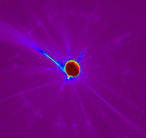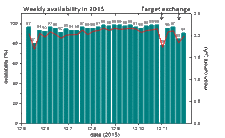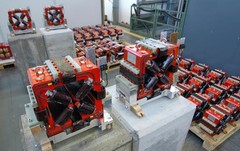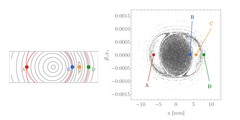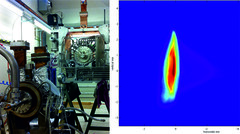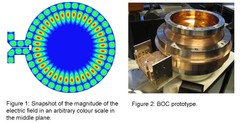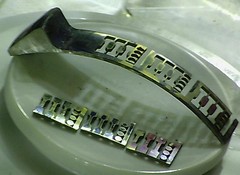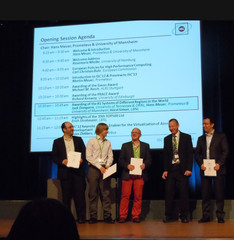Scientific Highlights
First Electron Beam in the SwissFEL Facility
On August, 24th 2016, the electron gun accelerated the first photo-electrons in SwissFEL up to the energy of 7 MeV, initiating the beam commissioning phase of the new SwissFEL facility. After several days of RF conditioning, the gun reached the nominal acceleration gradient of 100MV/m at an input power of 17MW with a pulse-width of 1 micro second at an operating frequency of at 2998.8 MHz.
Proton Accelerator Operation Statistics 2015
For the first time in the history of the High Intensity Proton Accelerator the availability of the facility reached an outstanding value of 95% in 2015 with a record value of 99.3% in week 44. In comparison to the two previous years this corresponds to a reduction of the downtime by 50%. The user operation in 2015 was started as scheduled and already in the first week the machine was available 97% of the scheduled beam time. In addition to the smooth operation of the facility, high intensity beam experiments could regularly be performed with currents of up to 2.4 mA. nu
GFA delivers the SwissFEL magnets on schedule
The Paul Scherrer Institut is building an X-ray free electron laser (SwissFEL) providing a source of intense, ultra-short pulses of coherent radiation in the wavelength range of 0.1 nm to 0.7nm. For the hard X-ray beam line, the magnet section in GFA/ATK has the responsibility for the design, the procurement and the magnetic qualification of 267 electro-magnets of 22 different types. Several design studies were performed in an attempt to meet the required magnet specifications while optimizing construction and operation cost.
ETH-Medal 2015 for outstanding MSc thesis
The detailed understanding of particle motion in the outer region (halo) of a bunched beam is of utmost importance for all existing and future high intensity hadron accelerators in view of minimizing particle losses and machine activation. Particle-core models separate the motion of halo particles from the core and treat them as test-particles. Therefore these reduced-order models are computationally inexpensive compared to full particle-in-cell simulations and can, to some extent, be derived analytically, thus giving insights into the non-linear mechanism of halo formation.
First beam from the SwissFEL electron gun
The new 3 GHz photocathode gun will provide the electron bunches for SwissFEL and has recently been installed in the SwissFEL injector test facility. There, it replaced the CTF2-gun 5, borrowed from CERN. The new gun is capable now of operation with 100Hz repetition frequency and a higher field on cathode and improved field symmetry. After RF conditioning of about 4 days, the gun reached the nominal acceleration gradient of 100 MV/m at an input power of about 17 MW and pulse-width of 1 microsecond.
RF Pulse compressor for the SwissFEL
The SwissFEL C-band (5.712 GHz) linac consists of 26 RF modules. Each module is composed of a single 50 MW klystron feeding a pulse compressor and four two meter long accelerating structures. The pulse compressor is a passive device that compresses in time the 3 μs pulse from klystron into a 330 ns pulse. The compressed power is then guided to the four accelerating structures. The pulse compressor is based on a single Barrel Open Cavity (BOC). The BOC makes use of a “whispering gallery” mode which has an intrinsically high quality factor and operates in resonant rotating wave regime (Figure 1); moreover, and contrary to the conventional SLED scheme, a single cavity is sufficient to define the pulse compressor, without the need for two cavities. A prototype has been manufactured by the Dutch company VDL (Figure 2) and successfully power tested in PSI reaching a peak power of 300 MW.
MEGAPIE samples delivered to partners for post irradiation investigation
The MEGAWatt Pilot Experiment was operated for neutron generation with the PSI high intensity proton beam in 2006. The experiment utilized liquid target material, a lead bismuth eutectic. This marked a major milestone towards Accelerator Driven Systems (ADS), which are intended to be used for the incineration of nuclear waste.
ETH Zurich, IBM and Paul Scherrer Institut Researchers receive 2012 PRACE Award
The MEGAWatt Pilot Experiment was operated for neutron generation with the PSI high intensity proton beam in 2006. The experiment utilized liquid target material, a lead bismuth eutectic. This marked a major milestone towards Accelerator Driven Systems (ADS), which are intended to be used for the incineration of nuclear waste.
Vertical Emittance of the SLS Storage Ring
On the 6th of December 2011 the vertical emittance of the SLS storage ring could be reduced to a world record low value of 1pm rad. The vertical beam size in the short straight sections of the SLS is then only 3 micron (rms). This was achieved through vertical re-alignment of the magnet girders with 400mA stored beam and fast orbit feedback running, as well as through application of several different methods of coupling suppression using 36 skew quadrupoles. High resolution profile monitor utilizing vertically polarized component of synchrotron radiation allowed precise determination of the beam size.
